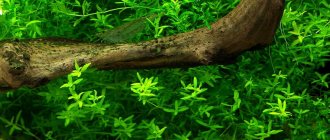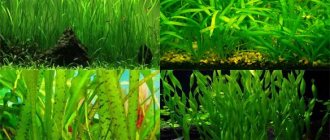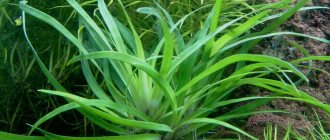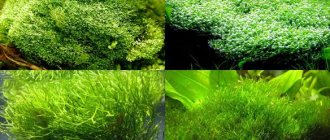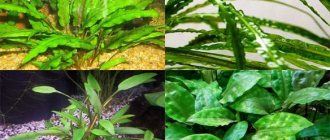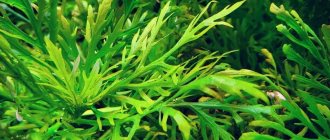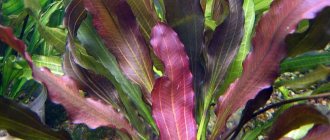Hemianthus micranthemoides is an exotic dicotyledonous plant from the Norichaceae family. In the hands of a skilled aquascaper, it easily takes the desired shape and fits harmoniously into any landscape.
| Name | Hemianthus micranthemoides |
| Kinds | Monte Carlo, shady, few-flowered, Hemianthus cuba |
| Color | Green |
| Dimensions | Width – up to 20 cm Height – up to 30 cm |
| Water | Temperature – 20-28 0C Acidity – 5.8-7.3 Hardness – 0-30 GH |
Description
The tender leaves are eaten by herbivorous and omnivorous fish.
Appearance
The soft stem stretches strongly upward, grows up to 300 mm, in whorls are 3–4 elliptical leaves with a pointed end, 3–6 x 1–2 mm. Petioles are not visible. The typical distance between whorls is 10 mm.
Abundance of side shoots. The cap is pronounced and floats in the water column.
The color is bright, light green.
Properties of Hemianthus micranthemoides:
- It grows actively, up to 100 mm in 30 days. Withstands hat trimming without damage.
- The roots are poorly developed, spreading along the soil from a dense substrate. Hemianthus tends to float in the absence of fixation.
- When the aquarium is purged with carbon dioxide and standard (0.7 W fluorescent lamp per liter of water), bubble oxygen is released. For which it received the nickname “hemianthus pearl grass.”
- Micranthemoides is prone to overgrowing with algae.
- The cap or green carpet is a refuge for fry and spawning fish from predators.
Lifespan
Not recorded due to constant growth and reproduction.
Confusion
Young Micranthemoides is confused with Hemianthus cubea, a related species.
The leaves of Hemianthus cube are smaller, the color is darker, without a point. The distance between the whorls is 2–4 mm. Height - 40–50 mm. Forms a green cover on the ground. Micranthemoides is supplied for sale in the form of a “rug”, which aggravates errors.
Beginner aquarists confuse it with a similar lysimachia. Lysimachia has larger and coarser leaves and fewer shoots. The stem is stiffer.
Hemianthus micranthemoides was mistakenly attributed to the families of plantain and noricaceae.
Trimming
Micranthemum pauciflora, planted in nutritious soil, tolerates pruning well and does not get sick even with large-scale pruning. Thanks to proper pruning, this plant can be adapted for any aquatic design needs. If you cut it very short, you can get an emerald mat lining the bottom of the aquarium. If you carefully cut off the top part of the bush, you can end up with a mid-ground plant. If you regularly trim the tops and side shoots, you can grow a dense, full bush that can be shaped.
Return to content
Kinds
There are subspecies with 2 and 3–4 leaves in a whorl. The former do not grow so quickly and tend to stretch. Not suitable for curly trimming of green caps.
Related species:
- Hemianthus cube.
- Micranthemum shady. Found naturally in the swamps of Central America. Rooted into the ground it grows vertically up to 200–2500 mm. The span of the bush is 120–140 mm. It also attaches to snags, stones and simply floats in the water column. Lighting - 0.7 W fluorescent lamp per liter of water 9-12 hours a day. Growth is active.
- Micrantemum Monte Carlo. Grows in flowing waters of Argentina. Similar to Hemianthus cube, but with a developed root system. The leaves are larger, up to 4 mm. Lighting - 0.5 W fluorescent lamp per liter of water. Grows up to 100 mm. Forms a green cover on the bottom.
How to plant and propagate
The following methods are used for planting pearl grass:
- The top of the plant is plucked off and planted in the ground. Soon the stem begins to branch and form new shoots.
- Several stems are cut crosswise and planted in the ground in two separate bunches.
- The stem is divided into parts, each of which is planted in the ground.
Hemianthus shoots can be tied to driftwood or stones. After some time, small roots will appear on them, and the plant itself will take the form of a tangled ball, suitable for creating original design compositions.
Keeping in an aquarium
Caring for Hemianthus micranthemoides is not a problem. The main thing is maintaining the required acidity and purging with carbon dioxide (CO2).
Water
Temperature: 22–26 °C.
Acidity: pH 6–7.2. When pH increases, nutrients are not absorbed by plants. Chelated metal compounds disintegrate and transform into a form inaccessible to micronthemoides.
Rigidity is not regulated. Determined by the presence of fish and aquarium plants of other species.
The main parameter for hemianthus is the CO2 content in water. It is determined by carbonate hardness kH and acidity.
Increased values are highlighted in yellow, decreased values are highlighted in blue.
At pH 7 and kH 6, the carbon dioxide content will be 19 mg/liter.
Shrimp can help estimate CO2 concentration. They hide from zones with a carbon dioxide content of 27–28 mg/l in plant thickets. If they swim all over the aquarium, increase the gas supply.
Ventilation is carried out using expensive gas cylinder equipment.
There are “folk” ways to produce CO2. Prepare mash in a plastic bottle. For an aquarium up to 150 liters, a 1.5 liter bottle is suitable. When fermenting, do not fill the container to the top, 2/3 is enough. For 1 liter of warm (30–40 °C) water, add ½ cup sugar, ¼ tablespoon yeast and ½ teaspoon soda. The remaining ingredients are to taste. Place the water seal into the aquarium. One refill is enough for 12–15 days.
Disadvantages: impossibility of dosing and switching off.
CO2 ventilation improves water quality. Plants absorb carbon dioxide and saturate the water with oxygen. The living inhabitants of the aquarium do not care about the CO2 content if it is less than 35 mg/liter.
Carbon dioxide is effective for preventing fish diseases. Has a bactericidal effect.
Filtration and weekly water changes of ¼ volume are required. Without replacement, the growth of algae in the aquarium will reach catastrophic proportions.
Priming
Sandy substrate with a fraction of 2–3 mm due to the underdevelopment of the root system. Depth - from 40 mm at the front wall, from 60 mm - at the rear and side. The slope will make it easier to clean from dirt. Add several small lumps of clay to the soil as fertilizer.
Lighting
The backlight intensity is standard, 40–60 lumens of luminous flux per 1 liter of water. Use energy-saving and cool fluorescent and LED lamps. Color temperature - from 5000 K. Daylight hours - 9–12. You can’t do it any longer: parasitic algae are growing.
Diseases - prevention and treatment
Hemianthus is an aquarium plant with strong immunity. But if it is not cared for properly or the conditions of detention are violated, it begins to get sick. Most often, hemianthus has the following problems:
- Stopping growth. The problem occurs when there is a lack of carbon monoxide and is easily solved by supplying carbon dioxide.
- Reduction of leaves, stretching and denudation of stems. The disease develops with insufficient lighting levels and is treated by using more powerful light sources and transplanting hemianthus under lighting fixtures.
- The upper leaves turn pale and growth stops. The cause of the development of the disease is a critical pH balance. The problem is eliminated by weekly replacement of 20-25% of the total volume of water and bringing the acidity to optimal levels.
- Covered with algae. Fast-growing algae entwine the bushes and injure the leaves, which leads to the death of the hemianthus. The problem occurs due to stagnation of water in the aquarium and too long daylight hours. The disease is treated by increasing filtration, systematically replacing part of the fluid and regulating lighting.
Hemianthus micranthemoides is a perennial herbaceous plant with small green leaves, widely used in aquatic design. Thanks to its ability to easily take on the desired form, the grass will become a real decoration for any aquarium.
What plants would you like to see in your aquarium?
Aquadesign
An aquarium for design is preferable to a traditional shape: a rectangular parallelepiped. The optimal ratio of height and width is 1/2–1/3. Create uniform lighting using fluorescent tubes, LED garlands, and remote LED spotlights.
If you plan to use micronthemoides for a green carpet, provide a “clearing” before laying stones and driftwood. The lawn will need to be mowed weekly. It’s better to form a green cover from a hemianthus cube. For perspective, choose angular stones. The larger, the farther from the front surface.
For a designer aquarium, an internal filter is inappropriate. Focus on the external one, with a productivity of 7–10 aquarium volumes per hour. Since abundant vegetation is planned, biofiltration is not necessary. CO2 ventilation is effective. Air purging is not necessary.
Plant the planned plants immediately when starting the aquarium. The carpet is formed in the center. Hemianthus micranthemoides bushes with a cap are used in the middle and background, on the sides.
The result of fixation of Micranthemoides on driftwood is interesting. Openwork driftwood interspersed with whitish roots grows.
Fill the aquarium with settled water in 3-4 doses every 1.5-2 days. Introduce living inhabitants when biological equilibrium is achieved. A couple of weeks. Start with shrimp.
The inhabitants of the aquarium are also an element of decoration. They look like small schooling fish with bright colors. The same neons.
Start trimming when the stem reaches a length of 100–120 mm. First pinch off the tops. Use the trimmed parts to increase the density of the bush. Perform a curly haircut after forming a dense hat. Do not allow the soil carpet to grow above 30–40 mm. There is a risk of plants being torn from the substrate.
Reviews
I first bought this Micronthemum hemianthus last summer, a few twigs. To this day I have an overgrown miracle with very lush caps, I constantly thin it out and remove the excess. Keeping it at home is no problem, it is not whimsical. As it turned out, it is not very dependent on lighting, although it grows worse where there is no sunlight.
My observations have shown that if light enters in large quantities, the plant stretches and loses its beauty and elegance.
Hemianthus is delicate and pleasant, and can be used to create unique interior design options. You can shorten it from the roots, or simply trim and shape the tops; this does not have a big role for it. Once a plant starts to grow, it is very difficult to stop it.
It tends to become overgrown with algae. The plant is sensitive to the acidity of water.
So, to summarize, Hemianthus micranthemoides is an aquarium plant with a pleasant bright green color. Used for aquarium decoration. I like it when it is looked after, fertilized, cut, forming a variety of curly hats. Doesn't cause any trouble and multiplies quickly.
Compatibility
The tender leaves will be eaten by herbivorous fish and shellfish. Of the mollusks, ampullaria are especially dangerous.
Omnivores gnaw leaves when there is a lack of plant food. The exception is catfish and bots. They will dig up and eat the whole plant, with roots.
View this post on Instagram
Posted by Green Aqua (@greenaquashop) Oct 26, 2021 at 9:09 am PDT
Cichlids and barbs are also incompatible with Hemianthus micranthemoides. Poeciliaceae and gourami are limitedly compatible.
They do not tolerate proximity to Vallisneria.
Interesting Facts
Hemianthus micranthemoides (glomeratus) develops quickly only in silty soil. If there is a clean bottom layer in the tank, preparation must be carried out. In comfortable conditions, the plant grows up to 25 cm.
Advice for aquarists who want to give their creation the most pleasant appearance possible: a chaotic skein of stems that looks quite original in different parts of the aquarium is obtained by fixing the bunch with stones or driftwood. It is not worth burying it in the ground.
Photo gallery
Useful lifehacks
So that you do not have problems with breeding Micranthemoides, use the observations of experienced aquarists:
- The first cutting after planting is done when the plant reaches 8-10 cm at half height. This manipulation promotes lush lateral branching of the bushes.
- The plant reacts negatively to aquarium medications.
- Without the supply of carbon dioxide, the leaf plates become less dense.
- The roots should be trimmed before planting. This accelerates growth.
- In low light the leaves darken.
- If the plant stops growing or the leaves turn pale, it does not have enough CO2.
- Yellow or red color of leaf blades is an indicator of the need to apply mineral fertilizers
- Micranthemoides is excellent for shrimp farmers.
Reproduction
Growing hemianthus will not be difficult, since it reproduces by cutting stems. Each shoot is planted separately using thin tweezers. The stem must be completely buried in the ground, leaving only the crown on the surface. Leave a space of 1 cm between the stems.
Cuttings
The apical cutting should be planted in the ground. After some time, roots will appear at the base. It is not advisable to leave Hemianthus micranthemoides floating freely. This will only slow down growth and also stop the formation of the root system.
Sorry, there are no surveys available at this time.
Diseases
Diseases appear when the recommended conditions are not met.
Seaweed
The main enemy is algae. Particularly prone to infestation by threadworms and blue-greens. They appear with 11–12 hours of daylight, sunlight and no water changes.
Overfeeding fish without removing food debris and excrement is dangerous. Overdose of fertilizers, lack of nitrates. Excessive levels of ammonia and nitrites in water (not absorbed by plants) stimulate the growth of algae.
Parasites entangle foliage. Prevent the entry of light, CO2 and nutrients. In advanced cases, they cause the death of the plant.
- The filament appears as greenish threads entangling the plant. Remove the parasite mechanically (with tweezers, toothbrush). Siphon the bottom, replace 1/3 third of the water. Or treat the algae with hydrogen peroxide from a syringe once a day. The maximum dose is 20 ml per 100 liters of container. Helps after 10–12 days.
- Blue-green algae is a slimy coating on the foliage and has a specific odor. Use antibiotics, erythromycin (sold in pharmacies). Crush the tablets. Change 1/4 of the water volume. Add the medicine to the aquarium at the rate of 400 mg of active substance per 100 liters of water. It will not cause harm to other inhabitants at this concentration. After 24 hours, siphon off any remaining algae and perform the change again.
Complete isolation of the aquarium from light for 72 hours helps against all types of algae. Turn on intensive air blowing. During this time, no one except parasites will die of hunger. Before and after photoisolation, change the water. Remove any leftovers. Attention, it is important to completely exclude all types of lighting. Otherwise the algae will come back.
Nutrient deficiencies
Lack of nitrogen or phosphorus causes yellowing and curling of leaves. Optimal concentrations: N - 0.01–0.02 mg/l (KNO3 is added), P - up to 0.001 mg/l (KH2PO4 is added).
Lack of potassium is expressed by yellowing of the edges of the foliage and spots. Normal content: 0.01–0.02 mg/l (addition of K2SO4).
It is effective to apply purchased complex fertilizers with macro- and microelements. Contain metal compounds, chelates. Available in the form of solutions, powders, tablets.
Content Disadvantages
- Hemianthus micranthemoides grows poorly due to unacceptable acidity and lack of carbon dioxide.
- Insufficient light causes the plant to reach for the light source. The foliage becomes smaller, the distance between the whorls increases.
Natural habitat
Micranthemum is classified as a Plantain plant (family Plantaginaceae), although it has nothing in common with the familiar common plantains. It is found in coastal areas of ponds and lakes, swampy areas, slow-moving rivers in tropical and subtropical areas.
The most common perennials in the Antilles grow in the south and north of the United States, the south of Northern Argentina and the territory of Paraguay. Several species of Micrantemum can be found in one area. But all of them are capable of growing on the bottom or surface of water and on land.

